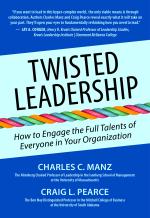“Twisted Leadership” Offers Energizing Insights
August 23, 2017

Don’t be fooled by Twisted Leadership’s ambiguous identity. The just-published guide to management leadership—Twisted Leadership*—by Nirenberg Professor of Business Leadership Charles Manz and his coauthor Craig Pearce has nothing (or little) to do with deviant behavior. An exception: it offers a potential cure for what they call the top-down “Leadership Disease.” In Manz’ sense of the word, “twisted” connotes the interwoven strands of four approaches to leadership. That quartet (what they call the 4 S’s) includes Self-Leadership, SuperLeadership, Shared Leadership, and Socially Responsible Leadership.
For decades, Manz and his colleagues have explored those “strands” in research and workshops. Firms of all shapes and sizes have road tested and refined each approach. But Twisted Leadership, emphasizes Manz, is something new. “It integrates all four approaches. With Twisted Leadership, we’ve figured out how to create a comprehensive, synergistic strategy.”
Four Strands of Leadership
By and large, Twisted Leadership avoids top-down, hierarchical leadership as inflexible and wasteful of human talent. The Twisted agenda, then, begins with empowerment of the individual through (decentralized) Self-Leadership, which marshals behavioral and cognitive strategies to foster self-motivation, self-direction, and business results. At the same time, Twisted Leadership acknowledges the reality of limited top-down roles through SuperLeadership (leading others to lead themselves). It strengthens an organization by modeling and encouraging Self-Leadership. And it adds value through big-picture coordination and rapid-response leadership in urgent situations.
The authors complement Self- and SuperLeadership with Shared Leadership, where participants share information and expertise in collaborative planning, work, and decision making. Participants with specific skills and aptitudes step forward (sometimes in tandem with others) to take the lead and offer insights and action initiatives. But they also learn to get out of the way and let others lead when different strengths are called for. “They need to sense when to step forward and when to back off,” notes Manz. “It’s a bit of a dance,” he says.
The final “S” strand in Twisted Leadership adds Socially Responsible Leadership to the fabric. Focusing on social responsibility, the authors advocate triple bottom-line (social, environmental, and financial) concerns. And they emphasize specific “virtuous” values in the workplace as a foundation for the other 3 S’s.

Twisted Leadership, says Manz, adapts and adjusts the four strands to shifting challenges and tasks. Shared leadership, for example, works best in team-collaborative settings that call for interdependence and creativity. But that same dynamic unchecked, he cautions, can create Groupthink, where uniformity of opinions rule. An antidote for that, he remarks, might be an injection of Self-Leadership, where an individual challenges the common thinking of the larger group. At the same time, Shared Leadership, through its emphasis on team values and team accountability, might reign in Self-Leadership’s potential for excessive individualism. Meanwhile, SuperLeadership, which promotes and supports Self-Leadership and Shared Leadership, might allow for decisive action in a situation that calls for a rapid response. And Socially Responsible Leadership provides values and a sustainable compass that confers “purpose” beyond just high performance.
While Twisted Leadership may be a culmination of Manz’s previous work, it also, he emphasizes, is a new horizon, a new adventure. It’s a work in progress—“a learning process where we are refining our understanding, especially in the field, of how the four leadership strands interact.” Those strands, he reminds us, are interwoven, which makes them quasi-organic and synergistic, greater than the sum of their parts.
Achieving Twisted Leadership, then, calls for a decisive commitment by an organization and its employees. Both must trust the tremendous potential of the workforce when allowed to develop and grow, to implement trial-and-error initiatives, and to adapt individually and collectively. “It’s a lot of work in the near term, but it saves a great deal of effort and waste later on,” Manz remarks. “Everyone, he insists, “is a leader of themselves and one another. And the payoff, he continues, “can unleash a long- term positive performance juggernaut and extraordinary results.”
*Charles Manz and Craig Pearce, Twisted Leadership: How to Engage the Full Talents of Everyone in Your Organization, Maven House Press